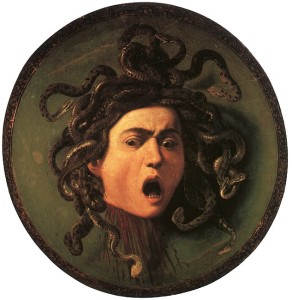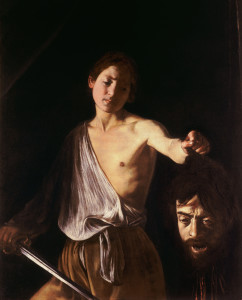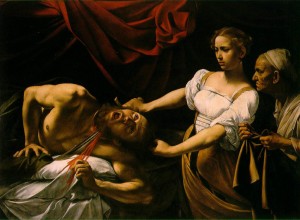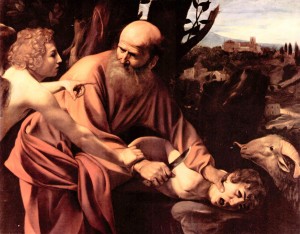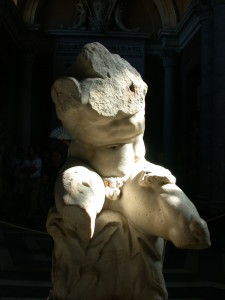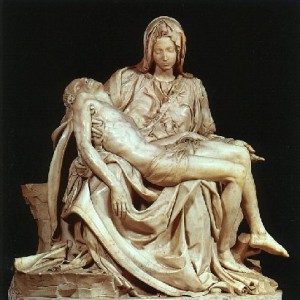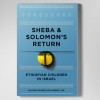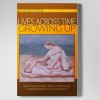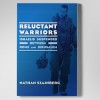12-9-05: To Jerusalem, and not yet back.
In Jerusalem, cafe Tmol Shilshom (the day before yesterday) sitting in Yehuda Amichai’s corner, around 5. Then back to Ra’anana. Today, after an early a.m. bike ride, bad spill, bent rear wheel, I collect myself, limping a bit like an old ‘rthitic farmer feeling the rain coming on. Deliver my bike to Pablo to repair, check email at Ra’anana’s Ilan’s Cafe, hop the bus to TA to give lecture at Geha hospital, one of the largest Psychiatric hospitals in Israel. ‘Natch, I am on the wrong bus, but relying on the goodness of strangers, the bus driver in this case, I am redirected at the Azraeli Twin Towers, to catch the Petah Tivka (Hope’s Opening) bus to Geha.
Talked about dream interpretation, a paper I wrote some two years ago, unpublished, in which I build on Erikson’s idea that dreams are dreamt at a certain moment in a person’s life, sometimes embracing an era’s dilemmas, and we can explore this fruitfully, using both latent and manifest content (the space, the time in the dream, the physicality of it and its sensuality). (Later published in Psychoanalytic Review and available on this blog site.) I give examples of a child’s dream, a young adult, older adult, followed by dreams in different phases of psychoanalysis, including an elegant end phase summary dream.
Well, to begin, Gil Zaltzman, new head of child psychiatry, does the usual nice introduction, then adds that I am an oleh hadash. First quiet clapping, then across the auditorium of some 60 faculty, the applause continues. At the end, applause again. And good questions, very good, making me think harder on the paper. They ask me to stay for lunch to talk more. The two administrative assistants attend the talk and thank me.
One, prior to the talk, tells me that her name is very Polish, Korscak, like the Polish doctor, Janusz Korszak, who chose to walk with his Jewish children into the gas chambers. But I tell her that I am fairly sure that Korscak was Jewish, only adopted a Polish name. She is shocked by this. We comb the internet, so excited, that my cup of mineral water is spilled. She makes nothing of this, mops up and continues surfing. A phone call comes, asking me to prepare for the presentation; we wave it off. Korscak found, she is surprised to learn of Korscak’s Judaism, how he chose a fictional character’s Polish name (later misspelled by a publisher) to assimilate better. Puts a different spin on his decsion to march with the Jewish children into the chambers to die. There is a Korscak Society. Bettelheim
revered Korscak.Sharon, the woman who guided over me the cell phone to Geha, made arrangements, and later calls my cab, tells me that her father and I were/are neighbors: I am thinking Ra’anana; she is meaning SF. He lives at 1620 Lake St, known for his Japanese Bonzai garden; down the block from 1720, my digs. Afterwards, she escorts me to the private dining room. She assures me the grub is good, fine victuals. People arrange for this dining room to cater events. Its tasty, although, I was remembering in Finland, at the hospital you could get some low-beer (2.5% alcohol) at lunch; well, not very good beer. We sat, an Israeli, Orthodox Jew who talked about treks to Peru, Chile, Tibet; an Argentine, who grew up in far north Argentina, once a thriving Yiddish community; Sharon and myself. The Argentine couldn’t speak English and my Spanish is limited to ordering burritos, so Hebrew it was, such as it was.Now, off to Jerusalem to volunteer for the army. My Tel Aviv cab driver, whom I fuel with
botz (Turkish coffee), enjoys the trip and before I fall asleep, says to me that the way for Jews to live together (he demonstrates with his hands) is with mountains between each Jew. These cab drivers are challenged, for they must use both hands to talk; driving interferes with this, only somewhat. The cup of
botz I give him, leads me to wonder if I have signed my death warrant, as he now prepares to empty a sacket of sugar (through a tiny tear) into the coffee cup, lid up-ended. I offer to sugar his coffee; waves me off. Thinks he can do it at a red light. But the hole he has torn from the edge of the packet permits only individual granules to trickle out. This continues for several blocks: hot, unlidded coffee in left hand, packet clutched in right, left foot working clutch; right doing brake/accelerate, and Newton’s laws of physics maintaining our course. Packet done, I worry he wants two, but he seems to settle for less-than-satisfactorily sweetened
botz. He has an immaculate Skoda diesel and his dress and finely tuned shadowed beard fits the car. His Russian accent is soft, but audible.The trick: find the
Lishkat Hagiyus, the army recruitment center, is to not ask people where is Rashi street. It exists — the street I mean — but, unlike Rashi the straightforward commentator, this Rashi road is a bit circuitous, s
treetus interruptus. As we approach the entrance to the city, he is quick on the questions for directions through the window. He has a piercing whistle: fingerless, he couples his tongue into a “V”, purses the lips a bit and lets loose, more a shriek than a whistle. I watch in his rearview mirrow, make feeble attempts; he consoles me that he has studied this since childhood. The directions vary from driver to driver, but he is quite sure which one trust — and is right. Had anyone simply said, “It’s a half block north of Jaffa Road, just a few blocks past the Central Bus Station,” the story and the chase would not have been so good. I think that I did mislead my driver as he was counting stop lights; he was probably correct that we should have turned earlier; he doesn’t hold this against me. We find Rashi, the street. But the numbers are descending, and we must ascend, just as Rashi lifts our understanding of Torah, my thoughts add. But Rashi is one-way (the street, I mean). My
nahag backs up, turns about, makes a left and a couple rights and we seem to be at the beginning of a street. He thinks it’s Rashi. (He’s correct.) But the numbers start at 99; we need 103. Where should be 103, is a children’s park. I offer to exit, let him head home to Tel Aviv so I can reconnoiter — preparation for any navigation I may need to do for the army. He makes sure that I leave nothing behind; I am sure to hand him my coffee cup, not to leave a trace of myself behind.I go to the building with white underthings flapping from the balcony; rows of underpants, t-shirts, proletarian lingerie, all wavering white, as if the building were surrendering. I scan its facade, the mortar crumbling between the Jerusalem boulders; yes, surrendering to time. I think of Amichai’s poem; he, as a child, watching the white sheets billowing in Jordanian-captured Jerusalem’s rooftops. These now belong to Jews, us. Work myself along the side of the building toward the children’s park. Tack starboard and discover there is what appears to be another street, although no traffic can pass; the children’s park blockading; Huit Clos, very Sartre. This street, unlabeled is triangled with 99 Rashi. I work myself along a wavy metal fence and ask the first young woman green-clad soldierette, where’s the
Lishkat Giyus. She points to the building beyond and behind a tree, behind a wall, limply, I see an Israeli flag; then the usual metal barricades, a bit haphazardly aligned. (Haphazard seems to be the Israeli aesthetic, make-do). Just tucked inside is an empty guard booth and outside it, two young guys sitting on metal chairs, one with legs up, rifles leaning on their laps. They greet me nonchalantly. Do not check my heavy back pack. (I feel I must look remarkably unthreatening; but I am doctorly done-up, Navy blazer and Armani shirt, bespoke British cap-toed oxfords, slightly pingeon toed. Direct me to the crowd of guys in front of the entrance.
Entering, I see a semicircular formica-clad desk. Behind which, tubby fellow, perhaps 35, flanked by two dolls in uniform. Almost ignore me. Then directs me up to fourth floor, turn left, then left again; ask for Tzahi. I ascend. Behind me ascends an oak-structured fellow in uniform, carrying upon the back of his trunk a uniformed young woman, he ascending two steps at a time, a regular “Yakov,” nipping at my heels. Rivulets, of soapy water descend the stairwell, greet me; a water fall in the midst of Jerusalem. I suspect someone is washing the floor above; look and see no-one. But a pool of brackish-looking liquid, bubbles thinly wandering its surface, is the source for this Ein Gedi down the stairs. I take care on the soapy stone stairwell. Occassional poster-size photos ascend the stairwell; most of guys in basic training, face into mud, crawling below barbed wire, rifle protected; a young girl in uniform, looking as if into the future, advertises the Navy. I think of the F. family in Ra’anana, olim from the States perhaps 15 years past, whose two daughters directly entered from high school a specialized computer programming unit in the Navy (I think); six years and no need to get B.A.; they will get fine jobs as soon as they leave, but of course, marry also. There is much youth here, milling about. Also plastic Heftys full of garbage in the hallway, tied, ready to go. Also desks in disarray. One floor has piles of “Intel Inside”-labelled boxes, a bit more orderly than the surroundings. Inside offices are throngs of youth; some offices have carrols, like in libraries, but as a rule, these kids aggregate, won’t be parsed off ffrom each other by artificial barriers. thse kids are clumpers, relish being together. Even an ocassional solo “office,” (closets with a desk and chairs) have kids spilling in and out.
The uniforms seem impoverished, these green drabs. These soldiers are thinly veiled; kids.
Tzahi found, of course with a buddy visiting his closet and door open to the balagan in the outer office, he eyeballs me. First question: “How old are you?” I try to draw myself up to full height and then some, shoulders squared,disguise the pain in my hip from morning fall, mumble “56,”then add, “Ani rofeh,” I’m a doctor. They eye each other now, responding, “Oh, a doctor, that’s something different. Perhaps as a volunteer.” Sends me downstairs to Ronit. To the first floor, hang a left, then a sharp right, then a left again; gives me an office number, which later almost corresponds to the correct room, off by only one doorway.Stumbling into an entrance foyer, then sharp left into the smallest closet imaginable where two girls sit, I ask for Ronit, and am directed to the “other room 115.” (Clever security tactics these; ambiguously placed building; ambiguously numbered rooms; really know how to fool an old fellow like me.)
“Ronit?” I ask of several possible Ronits (and mostly “Rons”). Here is a cluster of desks, some chairs corresponding to particular desks; some hovering between desks. I use my tactical techniques and go for the oldest looking Ronit. I score. She looks more mature than the others, a bit of a worn look in her eyes, a sense of tolerance of the youngsters around her; she must be at least twenty-two.
All the “Ronits” in this building sport long hair, past the shoulder tresses, simply held up — a pin or two. But, there are occasional repinnings, almost subconciously, while talking with someone, or typing or walking, there is an upsweep of the arms, a reach to a wandering tress and a simple repinning. An unself-conscious of their simple beauty.
Ronit checks me out. I should go talk with Tzahi. I — having maneuvered since entry with my Hebrew — explain that Tzahi sent me here. She scans me tip to toe again. “Why do you want to do this?” I restrain the ideological cant; want to help out in some way and have the time. Instead, simply, ” I’m an oleh hadash.” Asks if I have a medical license; confirm, although filed in some office in Petach Tikvah. She hands me a one-page form to complete. In Hebrew. The box with the “why question” I complete, briefly writing that I am finishing a book on Israeli soldiers. She looks.
“You do research?”
(Yes.)
“On American soldiers?”
(No, Israeli.)
Her face relaxes.
“O.K. We will call you.”
I offer to leave copies of my certificates. No need. Perhaps they have enough papers, files.
And I exit. Tubby-Gingy now sits with the guards, between their rifles and the entrance gate, as if his bulk and gingy hair could protect them from attack.
To the Mechane Yehuda market, which I relish entering, even though it means back pack inspection, usually by the young and elegantly lovely Ethiopian soldier, her beret slightly raked. The colors here, the people, so focused. Food vending, the exotica. Near the end, I take a new route and as I approach an exit to Agrripas, find a small both fronted by a vender, Ari-ben-something-or-other, who does natural stuff. Ari has an ivory-tinted knit kipa from under which emerges curled thatch, from which seem to descend a descent lengthed beard. His short filthy white jacket, like an intern’s barely covers his overalls. He has two, three people clustered about and to his right he has the typical four or five transparent cube-shaped drink mixer-dispensers. Their paddles rotate slowly. But the colors within are new, strange; an emerald tinged soupy drink is called etrogot, the liquid of etrogs. Within it are suspended seeds — black ova — sluggishly sloshing about the liquid, like some primeval slime from which life would evolve. He is the softly ruby-tinted pomolite drink. He give me thimble-sized quaff of etrogot, not taking eyes off the other prospects. Before I can finish it, he whips away the thimble and adds pomolite. Delicious. He asks a shekel. Given. He is spraying something he has hand mixed onto the face of a fellow; tells him to massage it in vigourously. Asks me to step forward, close eyes, spritzes me forehead to eyelids to cheeks. Has a lemony-fragrance. Brings to mind Leopold Bloom’s bar of lemon soap, wrapped in tissue in his inner coat pocket as he wanders Dublin.
Now for the young woman, he takes greater care spritzing. Asks us if we notice how this relaxes us. (I won’t disillusion him; I probably couldn’t. But, entertaining he is.) Now, as I continue to massage this citrusy oil, I see him beckon the young fraulein approach. Close the eyes, he requests. But just before she lid-locks, he points to the bamboo-looking bells above his right shoulder, and purses his left fingers before her face, making a milking motion, as if trying to draw some adverse energies out of her face, through the tip of her nose, it seems. She stands, eye-closed, and Ari-ben-etc… softly jangles the bamboo bells, clacking more than tinkling, and his left hand continues finger milking before her face. This takes perhaps a minute, maybe more. He asks her softly if she is feeling relaxation. Polite, she says nothing. Opens her eyes. He asks, did she notice that she couldn not hear the sounds from the street. Not clear if the bell-clacking and finger milking stuffed up her ears, but the woman is polite.
Next, he does a negotiation with a bearded fellow over the face spray; two versions, I gather in Hebrew, perhaps one for the whole body. The fellow hesitates over the cost, then bottle proffered by Ari-ben-etc…, the man brings home something for the wife, his Molly Bloom.
Looking for nigunim, prayer songs, for my father (But, who really wants anything that sounds like Lodz cantors.) Well, this is the Middle East; singers do Mizrahi, not “Peilsher.” I find seven cassetes on sale of Tehillim, Psalms of David the King (The Lord is my shepherd, I shall not want). Listen. Sounds Morrocan to me, the tunes, but the salesman corrects me; Yerushalmi. Dad won’t dig this. I hesitate, then buy them for myself. I need to also buy a tape player (Now that I am wedded to my iPod) and plan to sit, read in Hebrew and English and listen to the Yerushalmi chant of Solomon’s poems.
Now, for a rest. Did Tmol Shilshom last night. The last Bellow talk, I think. Several people asked for more, but I am not sure David Erlich, the owner, can shut down half the cafe for the dozen and half attendees, poor fellows like me, so dependent on English. Will see.

